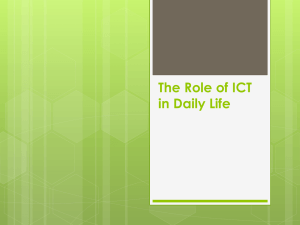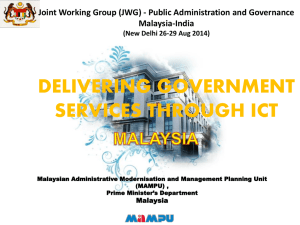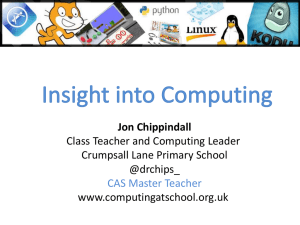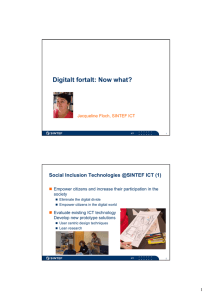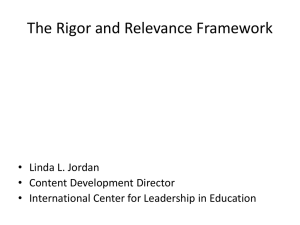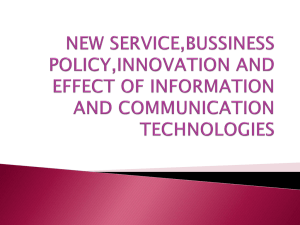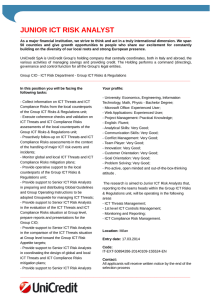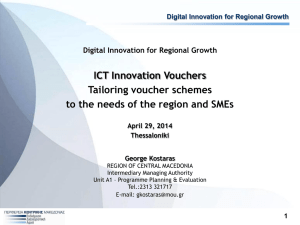Skills, competencies & processes: Internet Guidance
advertisement
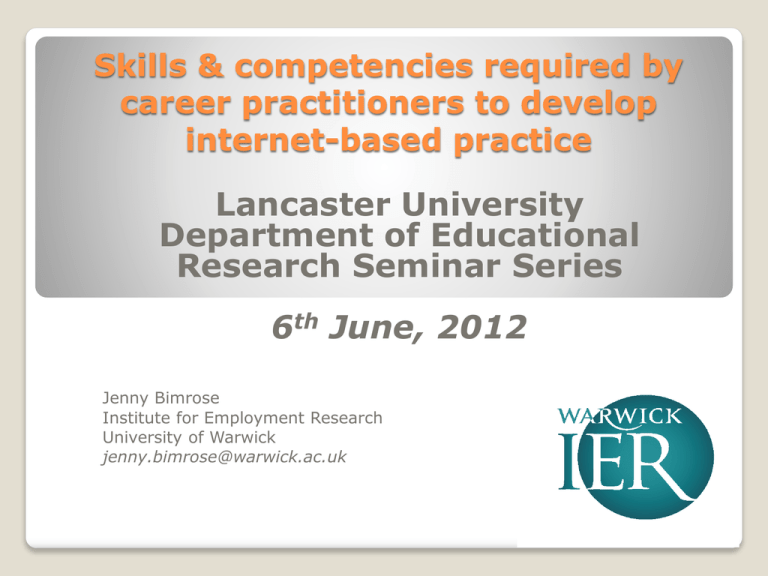
Skills & competencies required by career practitioners to develop internet-based practice Lancaster University Department of Educational Research Seminar Series 6th June, 2012 Jenny Bimrose Institute for Employment Research University of Warwick jenny.bimrose@warwick.ac.uk Outline Research method/findings Follow-on research Future indications? ICT: Policy Context ‘…young people today want and expect to secure IAG from a range of sources beyond formal careers advice…’ ‘Our IAG offer for young people will exploit a range of digital technologies’ Ref: Department for Children Schools and Families (2009). Quality, Choice & Aspiration: A strategy for young people's information, advice and guidance. London: HM Government. Retrieved 26 October 2009, from http://publications.dcsf.gov.uk/eOrderingDownload/IAGReport-v2.pdf. (DCSF, 2009b, p.13) ICT for CEIAG: Workforce Capacity? ‘...the knowledge base of the Career Guidance workforce which is necessary to use ICT technology can be lacking ... This is not conducive to the direction in which the occupation as a whole is moving...’ Ref: Cobbett, D., Dodd, F., Miller, S. and Shearer, L. (2009). Skills needs and training supply for career guidance – a gap analysis. Newcastle upon Tyne: Trends Business Research Ltd. Research questions? Skills & competencies: Which are required to deliver on ICT-based CEIAG? Workforce capacity: Is there a skills gap? Evidence-based practice? Research: 2009/2010 (CfBT) Literature review Fieldwork Data analysis & write-up ICT: Use of language Lack of consistency Web-based E-Guidance guidance Internetbased guidance ICT: Current usage in CEIAG Resource: most exploited Communication: embryonic Materials: underdeveloped Skills & competencies for ICTbased CEIAG ICT user skills Digital skills Guidance skills Digital Skills Social/ Cognitive/ personal Physical Technical Digital Skills: Social/Personal Communication General Knowledge Creativity Collaboration Self-Esteem Parallel processing Persistence Peer-to-peer learning Risk-taking Digital Skills Cognitive/Physical Multi-tasking Logical thinking Problem solving Trial & error learning Technical Hand-eye coordination Technical confidence Web-design Content creation Evidence-based practice? Fieldwork Small scale, mixed method empirical study 6 sites across England (Connexions) Varied delivery contexts and geographical locations Data collection: YP, PAs and managers Data collection: Young People •7 focus groups [46 YP] •46% male, 54% female •Years 8 to 13 •35-60 minutes •Range of materials used YP’s experiences of CEIAG • Available services: high level of awareness • Participation: high - various methods • Telephone and email: low level of usage • Career information: mixed response • Varied search strategies: deployed • National website [Connexions Direct]: low level of usage YP’s aspirations: ICT in guidance Multimedia information Chat rooms BUT retain one-to-one Email communication Social networking Data collection: P.A.s & Managers • Interviews: 11 P.A.s & 6 managers • 18% male, 82% female • Majority qualified [Dip CG, QCG, NVQ • • Level 4] CPD – high levels of participation Variety of contexts P.A.s & managers current use of ICT in service delivery • Limited • Potential to develop this part of practice • embraced enthusiastically (generally!) Brakes: ~ technological infrastructure ~ resources ~ confidence Skills & competencies: findings • Majority ‘high’ or ‘medium’ for most essential • digital skills Most support required for skills in web design and content creation Overall: workforce well positioned to develop confidence and additional skills to engage effectively in internet-based guidance delivery Context: shifting paradigms From this…. To this…… ICT: Policy Context …..further integration of ICT into careers service delivery is essential for effective delivery of services, a number of key issues need to be resolved before its successful implementation can be achieved fully. These include CPD support for careers professionals…… ICT specification for the all-age service to ensure this supports fully integrated provision. Ref: Careers Profession Task Force Composite Progress Report to Ministers, March 2012 ICT: Policy Context ‘…the existing funding for face-to-face career guidance services for young people has been allowed to vanish without trace, without any public announcement to this effect. Most existing Connexions career guidance services for young people have being eroded or dismantled by Local Authority cuts. Schools now have to pay for services they previously received free of charge’. Ref: Careers England Policy Commentary 15B (Final Version): The Coalition’s Emerging Policies on Career Guidance (May 2012) ICT in IAG - Current usage? TELEPHONE INTERVIEWS STAKEHOLDERS • Ten recorded • Different sectors • CEOs to practitioners • Private to public ICT in IAG - Themes Levels of integration Future plans Drivers Organisational implications Timelines Future landscape Evaluation Workforce capacity Levels of integration Reactive – ad hoc response to requests Ongoing need (‘not part of initial training’) ICT competence (‘tricky, sticky & leaky’) Contracts – ambiguity [uncertainty + targets] ‘The more negative experiences CAs have of technology based systems, the more difficult it is to persuade them to embrace its usage more widely in practice’. Technological Frames Assumptions, expectations & beliefs about ICT that are both informed by, & inform, ideas and assumptions toward ICT, are embedded within the organisational culture Incongruent, or inaccurate technological frames are associated with problems during the adoption/ use of new ICT in organisations (Menold, 2009) Workforce capacity Continuum: ‘ICT not used a lot currently’ - to integral to service delivery Varied examples of innovative practice, but mainly for information & administration Separate strands – little integration Social networking – a feature Ad hoc development ICT & IAG: Future skill needs? Contingent on: Emerging & currently diffusing models of practice (i.e. role of ICT in delivery of services) Changing characteristics of the various sub-sectors (e.g. public v. private sector; shape of services, etc.) Shifting nature of the core expertise of practitioners (i.e. impact of the worldwide web) ICT: Past, Present & Future Web 1.0 Web 2.0 Web 3.0 • Access to information • User-generated content • Portable, personal web Future indications: UKCES ‘……to develop a prototype database drawing on existing data sources, with the specific purpose of testing the feasibility in practice of creating a comprehensive repository of careers labour market information (LMI) over the longer term’. Outcome: advice on the feasibility of developing a careers database of robust LMI, to be opened up for multiple interfaces for a range of users Future indications February – March, 2012 Career database (LMI4U) Feasibility study – open & linked data Hackday Report for Ministers Future indications ‘For high quality, robust LMI to have the maximum impact when used in a variety of career-related contexts, additional support will be needed that goes beyond simple access to data. Thought needs to be given to the ways different data sets need to reflect the particular needs of particular user groups’. Ref: ‘LMI for All’ Career Database Project - Processes Adapted and Lesson Learned (2012) Unpublished. Skills & competencies for internetbased guidance Thank you! Reference: Bimrose, J., Barnes, S-A. and Attwell, G. (2010) 'An investigation into the skills needed by Connexions Personal Adviers to develop internet-based guidance.', Reading: CfBT Education Trust, Report of an empirical investigation into the demand from young people for internet-based guidance, together with the readiness of Connexions services to deliver. (Full & Executive Reports are available online.) http://www.cfbt.com/evidenceforeducation/our_research/evidence_for_youth/advice_ and_guidance/connexions_personal_advisors.aspx Bimrose, J., Hughes, D. & Barnes, S-A (2011) 'Integrating new technologies into careers practice: Extending the knowledge base', Wath-upon-Dearne, London: UK Commission for Employment and Skills, http://www.ukces.org.uk/assets/ukces/docs/publications/integrating-new-technololgies-into-careerspractice.pdf



